What’s In a Name?
How animals earn their monikers can be surprising. Their common names can come from the places they’re found, the people who discovered them or even fictional characters. The names of the ten Aquarium residents below are inspired by their appearance and/or actions.
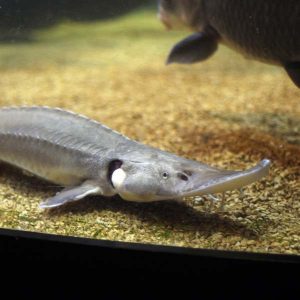 Shovelnose Sturgeon – Check out that shovel-shaped snout.
Shovelnose Sturgeon – Check out that shovel-shaped snout.
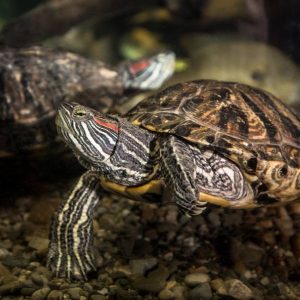 Red-eared Slider – This turtle is named for the red patch on its ear AND the way it slides into the water when startled.
Red-eared Slider – This turtle is named for the red patch on its ear AND the way it slides into the water when startled.
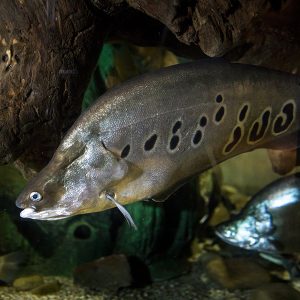 Clown Knifefish – This fish’s knife-like shape allows it to swim both forwards and backwards.
Clown Knifefish – This fish’s knife-like shape allows it to swim both forwards and backwards.
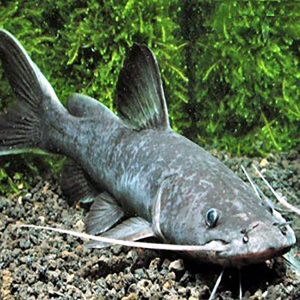 Crystal-eyed Catfish – Frank Sinatra might have been “ol’ blue eyes,” but this catfish gets attention for its light blue peepers.
Crystal-eyed Catfish – Frank Sinatra might have been “ol’ blue eyes,” but this catfish gets attention for its light blue peepers.
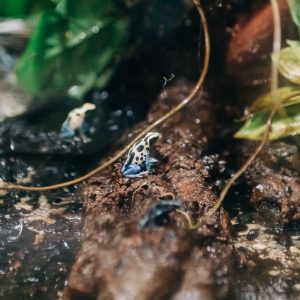 Dyeing Poison Dart Frog – This name comes from an unverified legend that indigenous people used these colorful frogs to dye parrot feathers.
Dyeing Poison Dart Frog – This name comes from an unverified legend that indigenous people used these colorful frogs to dye parrot feathers.
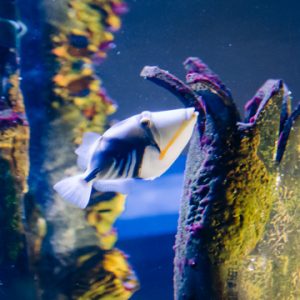 Picasso Triggerfish – This peculiar-looking fish has bright, artsy colors AND a dorsal spine will raise when startled.
Picasso Triggerfish – This peculiar-looking fish has bright, artsy colors AND a dorsal spine will raise when startled.
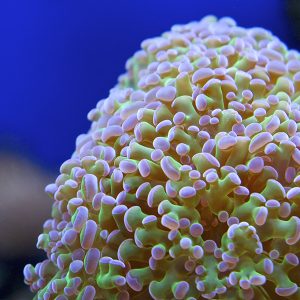 Hammer Coral – Note the hammer shape of these coral polyps.
Hammer Coral – Note the hammer shape of these coral polyps.
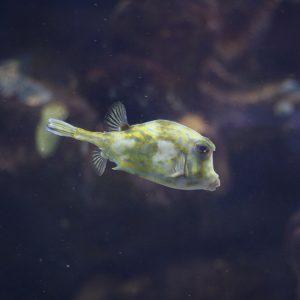 Scrawled Cowfish – The “horns” above its eyes and irregular body markings are what give the scrawled cowfish a distinctive appearance.
Scrawled Cowfish – The “horns” above its eyes and irregular body markings are what give the scrawled cowfish a distinctive appearance.
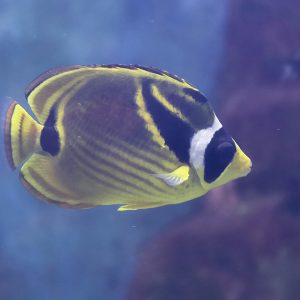 Raccoon Butterflyfish – This butterflyfish is named for the black-and-white “mask” around its eyes.
Raccoon Butterflyfish – This butterflyfish is named for the black-and-white “mask” around its eyes.
 Black Drum – This fish can make drumming or croaking sounds with muscle movement around its swim bladder.
Black Drum – This fish can make drumming or croaking sounds with muscle movement around its swim bladder.
See these and other animals with interesting names and backstories at Greater Cleveland Aquarium.
-Lili F.
*Hammer Coral Photo Courtesy David Davies, via Flickr.com

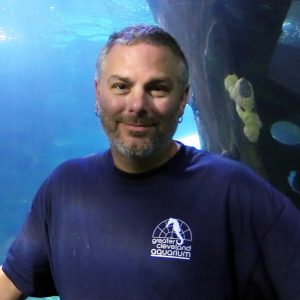 “Growing up, we learn about history through books. We even get to take trips and see battlefields, buildings, and relics. Few of us ever get to see the evidence, examine it, lay eyes on the details and the human element,” begins Mike Gorek. Mike is Senior Maintenance Engineer at Greater Cleveland Aquarium, and we like to say that he’s been here since before we had water. He’s talking about a remarkable dive trip – a liveaboard at Chuuk Lagoon in Micronesia.
“Growing up, we learn about history through books. We even get to take trips and see battlefields, buildings, and relics. Few of us ever get to see the evidence, examine it, lay eyes on the details and the human element,” begins Mike Gorek. Mike is Senior Maintenance Engineer at Greater Cleveland Aquarium, and we like to say that he’s been here since before we had water. He’s talking about a remarkable dive trip – a liveaboard at Chuuk Lagoon in Micronesia. Nicknamed the “Soft Coral Capital of the World” by none other than famous oceanographic explorer Jean-Michel Cousteau (son of Jacques), the islands of Fiji are a year-round diving destination filled to the brim with assorted sea life.
Nicknamed the “Soft Coral Capital of the World” by none other than famous oceanographic explorer Jean-Michel Cousteau (son of Jacques), the islands of Fiji are a year-round diving destination filled to the brim with assorted sea life.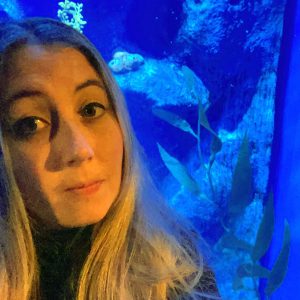 Kona, Hawaii is world-renowned for two things: Kona coffee and swimming with manta rays at night.
Kona, Hawaii is world-renowned for two things: Kona coffee and swimming with manta rays at night. Not every diver seeks tropical water and colorful fish. For some, the lure of historic shipwrecks or the challenge of cold-water diving draw them further north and inland to freshwater lakes. The Great Lakes is a wonderful location to find thousands of wrecks that, due to the lack of corrosive saltwater and stronger ocean currents, tend to be better preserved.
Not every diver seeks tropical water and colorful fish. For some, the lure of historic shipwrecks or the challenge of cold-water diving draw them further north and inland to freshwater lakes. The Great Lakes is a wonderful location to find thousands of wrecks that, due to the lack of corrosive saltwater and stronger ocean currents, tend to be better preserved. In 1999, a daring spearfisherman in Greece named Manolis Efthymakis made a stunning discovery. While free-diving 30 feet down, he saw an opening in the cliff wall and did what most of us would not: he swam into it. What he found drew the interest of both the diving and the archaeological community.
In 1999, a daring spearfisherman in Greece named Manolis Efthymakis made a stunning discovery. While free-diving 30 feet down, he saw an opening in the cliff wall and did what most of us would not: he swam into it. What he found drew the interest of both the diving and the archaeological community.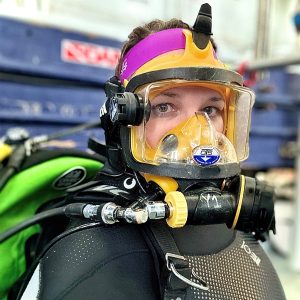 Just eight degrees south of the equator and nearly 10,000 miles from Cleveland, the island of Bali is a province of Indonesia and lies within the Coral Triangle, an area of immense biodiversity between the Pacific and Indian Oceans.
Just eight degrees south of the equator and nearly 10,000 miles from Cleveland, the island of Bali is a province of Indonesia and lies within the Coral Triangle, an area of immense biodiversity between the Pacific and Indian Oceans.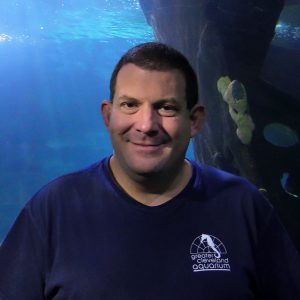 A shade over 66 million years ago, a six-mile-wide meteor came screaming out of the heavens at 12 miles per second and a 60-degree angle to the surface of the Earth, which is kind of a worst-case scenario angle in terms of plunging chunks of space rock. It absolutely pulverized the impact zone with the force of a 100 million megaton bomb, creating tsunamis hundreds of feet high and flinging rocks half a continent away. For non-avian dinosaurs, the impact marked the end of an era. Literally. This is where the Mesozoic Era ended, and the Cenozoic began—the infamous K-T Extinction that eliminated roughly 80 percent of all species on the planet.
A shade over 66 million years ago, a six-mile-wide meteor came screaming out of the heavens at 12 miles per second and a 60-degree angle to the surface of the Earth, which is kind of a worst-case scenario angle in terms of plunging chunks of space rock. It absolutely pulverized the impact zone with the force of a 100 million megaton bomb, creating tsunamis hundreds of feet high and flinging rocks half a continent away. For non-avian dinosaurs, the impact marked the end of an era. Literally. This is where the Mesozoic Era ended, and the Cenozoic began—the infamous K-T Extinction that eliminated roughly 80 percent of all species on the planet. When
When